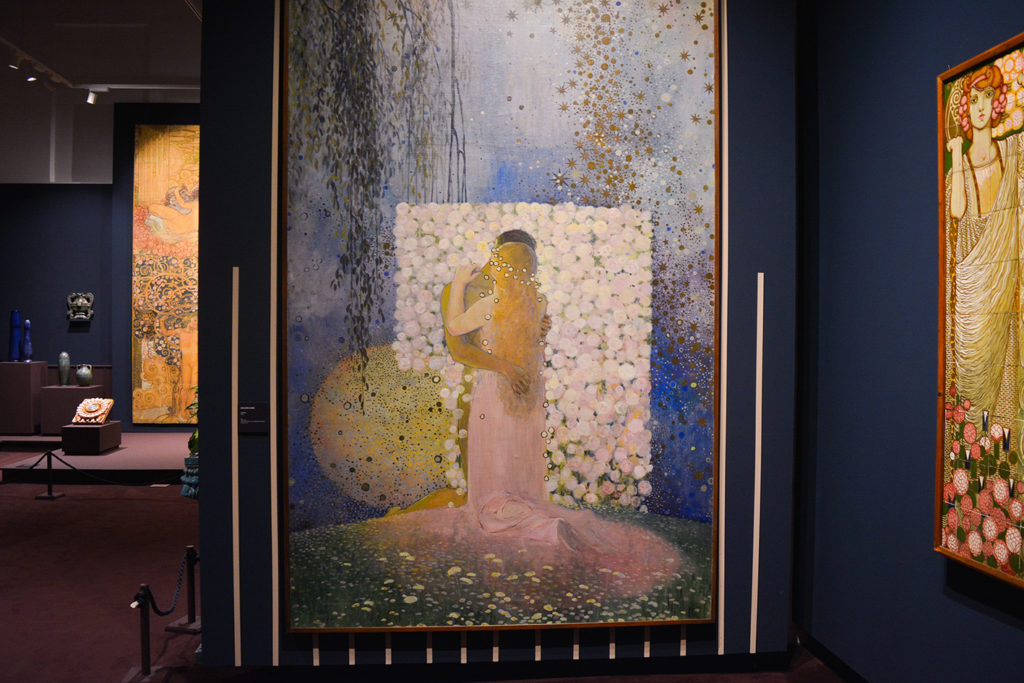
Until April 28, 2019: Horizons of Water Art Exhibition: PALP Praetorian Palace Pontedera. Hours: Tues. through Sun. 10 am – 8 pm. Admission: €6
Across the globe, from Florence to Bangkok, through styles of symbolism and divisionism, dive into the world of Galileo Chini in his diverse and fascinating artwork. Until Easter week, the “Horizons of Water Between Painting and Decorative Arts” show will feature some of Galileo Chini’s most interesting and expressive art pieces, along with other inspiring artists at a town near Pisa.
Embark on a journey through rooms of artwork; paintings, sketches, and ceramics, all bringing us closer to knowing the world he saw. Four sections are divided in Symbolism and Divisionism, Water as the Subject of Decorative Production, Orientalism and the Secessionist and Klimt phase.
Born in Florence in 1873, Galileo Chini became a painter and ceramist famous throughout Italy. After his father’s death in 1886, Chini was exposed to the arts through working with his uncle, who was a decorator and restorer. In 1890 he began attending lessons at the Academy of Fine Arts in Florence, and eventually obtained the family business after his Uncle’s death. Together with four of his friends, he created “the Art of Ceramics” in a small factory in 1896, and his work with ceramics introduced the Liberty, also known as Art Nouveau, style to Florence.
Chini later traveled to Bangkok in 1911, commissioned to decorate the throne room of the King of Siam, and remained there for three years. From 1901 to 1936 he was also a major contributor to the Venice Biennale, and other exhibitions in London and Turin. Chini also taught at the Accademia di Belle Arti in Florence and in Rome. Later in his life he suffered from depression, and in search of happiness remembered his time spent with the Macchiaioli artists. He then spent more time creating art inspired by landscapes, and happily continued this for the remainder of his life, until 1956.
Enter the first room titled Chini’s International Debut, full of earthy colors, golden light, and grey and blue accents, which sustains a calming feeling. Gain insight into Chini’s accomplishments through his painting La Fabbrica (The Factory), which pictures Chini alongside his brothers in the small studio they founded, L’arte della Ceramica. His wife is shown with arms outstretched towards the open window, symbolizing his muse and inspiration.
Continuing into the second room, divisionism comes to life. In this technique an artist, instead of blending, separates the colors into individual dots or patches which interact optically. See Il Cancello, translated as the Gate, a work depicting a colorful sky of blue, pink, red, and orange. A golden light radiating across the snow through the cracks of a wooden gate creates a hopeful feeling of looking towards the future.
Surrounded by a calming teal blue, the next room dedicated to his water subjects, one fittingly feels almost immersed in a fishbowl. Sketches and ceramics of detailed fish and water creatures create a similar style to that of Art Nouveau, characterized by its use of a long, smooth, line that is both wavelike and asymmetrical. Water remains a prominent inspiration throughout Chini’s work, in the room dedicated to Sea and Rivers from his life, view paintings of the Arno river, Lake Como, the Tyrrhenian and Sicilian coast line. Admire the “Beaches of Versilia after the Second World War,” with stormy skies, scattered wreckage and animal skeletons, and feel the somber but beautiful tones of his illustrations.
A tone shift to a more playful and imaginative take brings us to portraits of children playing in poppies and dancing. Galileo Chini continues his diverse use of art style painting birds hovering above the sea, illustrated with ties to Japonism (Japan-inspired art). Portraits and depictions of life in the in The Far East follows, as we journey with Chini in his travels. Here we see his ties to Orientalism from his time spent in Bangkok. See artwork inspired by the coronation of King Rama VI, depictions of Buddha, and life of the Siam people. Venture further into the room titled “From the Monn Dancer to Turandot,” featuring women from different cultures around the world, full of bright colors and unique styles.
Finally the visitor experiences the Secessionist and Klimt phase, with beautiful and dreamlike images. In his painting L’amore, “The Love” a couple embrace in an enchanting and flowery garden, surrounded by soft pastels, and gold accents. Walk into the final room holding a large collection of his ceramics, featuring plants, flowers, birds, and reptiles, called “Galileo Chini’s Garden of Symbols.” Throughout the exhibition also see works from Plinio Nomellini, who was a friend of Chini’s, Duilio Cambellotti, an exponent of Art Deco in Rome, Leonardo Bistolfi, a promoter of the international Decorative Arts Exhibition Turin, Vittorio Zecchin, a Klimt-style artist from Venice, and many more.
The art show is open Tuesday through Sunday from 10 am to 8 pm. Admission is € 8, with reduced prices at € 6. Don’t miss this opportunity to expand your mind with Galileo Chini’s perspective of the world, expressed through diverse art work in this exhibition with inspirations from across the globe. (nicole grant)








